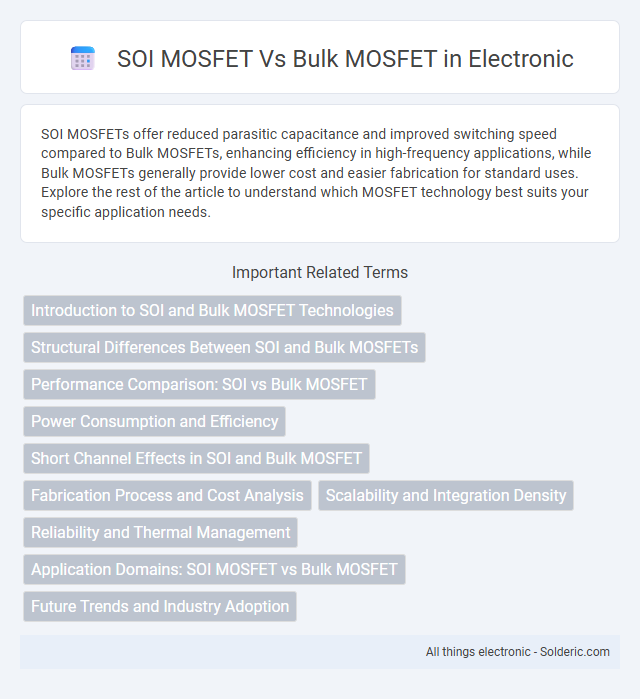SOI MOSFETs offer reduced parasitic capacitance and improved switching speed compared to Bulk MOSFETs, enhancing efficiency in high-frequency applications, while Bulk MOSFETs generally provide lower cost and easier fabrication for standard uses. Explore the rest of the article to understand which MOSFET technology best suits your specific application needs.
Comparison Table
| Feature | SOI MOSFET | Bulk MOSFET |
|---|---|---|
| Substrate | Silicon-On-Insulator (SOI) wafer with buried oxide layer | Bulk silicon substrate |
| Parasitic Capacitance | Lower parasitic capacitance | Higher parasitic capacitance |
| Leakage Current | Reduced leakage current | Higher leakage current |
| Short Channel Effects | Better suppression of short channel effects | More pronounced short channel effects |
| Speed | Higher switching speed | Lower switching speed |
| Power Consumption | Lower power consumption | Higher power consumption |
| Cost | Higher fabrication cost | Lower fabrication cost |
| Thermal Dissipation | Poorer heat dissipation | Better heat dissipation |
| Radiation Hardness | Enhanced radiation hardness | Lower radiation hardness |
| Application | High-performance, low-power and RF circuits | General-purpose digital and analog circuits |
Introduction to SOI and Bulk MOSFET Technologies
SOI MOSFETs utilize a silicon-on-insulator structure where a thin silicon layer rests on an insulating substrate, reducing parasitic capacitance and improving performance in high-speed and low-power applications. Bulk MOSFETs are built directly on a silicon substrate without an insulating layer, which can lead to higher substrate leakage and lower efficiency at smaller geometries. Understanding the differences in fabrication and electrical characteristics between SOI and Bulk MOSFETs helps optimize your device design for specific circuit requirements.
Structural Differences Between SOI and Bulk MOSFETs
SOI MOSFETs feature a thin silicon layer separated from the substrate by a buried oxide (BOX) layer, whereas Bulk MOSFETs are fabricated directly on a silicon substrate without this insulating layer. The BOX in SOI devices reduces parasitic capacitances and leakage currents by isolating the active region, unlike Bulk MOSFETs where the channel shares a direct interface with the substrate. This structural distinction enables SOI MOSFETs to achieve better performance in terms of switching speed and power efficiency compared to their Bulk counterparts.
Performance Comparison: SOI vs Bulk MOSFET
SOI MOSFETs exhibit significantly reduced parasitic capacitance compared to Bulk MOSFETs, leading to higher switching speeds and lower power consumption. The isolation provided by the buried oxide layer in SOI devices minimizes leakage currents and short-channel effects, enhancing device reliability and scaling potential. Conversely, Bulk MOSFETs often suffer from substrate noise and higher junction capacitance, which can degrade performance in high-frequency and low-power applications.
Power Consumption and Efficiency
SOI MOSFETs reduce power consumption by minimizing parasitic capacitance and leakage currents, resulting in higher efficiency compared to Bulk MOSFETs. The thin insulating layer in SOI technology enhances switching speed and lowers power dissipation, making it ideal for low-power applications. Your choice of SOI MOSFETs can improve overall system energy efficiency and thermal management in power-sensitive designs.
Short Channel Effects in SOI and Bulk MOSFET
Short channel effects (SCE) in SOI MOSFETs are significantly reduced compared to bulk MOSFETs due to the insulating buried oxide layer, which minimizes parasitic capacitance and suppresses leakage currents. Bulk MOSFETs suffer more from drain-induced barrier lowering (DIBL) and channel length modulation as the silicon substrate allows greater electrostatic coupling between the drain and source regions. Your choice of SOI MOSFETs provides enhanced control over short channel behavior, enabling improved device scaling and performance in advanced integrated circuits.
Fabrication Process and Cost Analysis
SOI MOSFETs are fabricated using a layered silicon-insulator-silicon substrate that reduces parasitic capacitance, improving performance but requiring complex processes like wafer bonding or separation by implanted oxygen (SIMOX). Bulk MOSFET fabrication involves standard silicon wafers with fewer steps and lower material costs, making it more cost-effective for high-volume production. However, the advanced insulation in SOI devices leads to higher fabrication costs but offers better speed, power efficiency, and reduced short-channel effects compared to bulk MOSFETs.
Scalability and Integration Density
SOI MOSFETs offer superior scalability and higher integration density compared to Bulk MOSFETs due to reduced parasitic capacitance and minimized short-channel effects, enabling smaller device footprints. Bulk MOSFETs face challenges in scaling beyond certain technology nodes because of body effect and increased leakage currents. Your designs benefit from SOI technology's ability to maintain performance at advanced nodes, supporting more compact and efficient integrated circuits.
Reliability and Thermal Management
SOI MOSFETs offer enhanced reliability due to reduced parasitic capacitance and minimized latch-up risk, improving device stability under high-voltage stress compared to Bulk MOSFETs. Thermal management in SOI devices is more challenging because the buried oxide layer acts as a thermal insulator, causing heat dissipation limitations and requiring advanced cooling solutions. In contrast, Bulk MOSFETs benefit from direct heat conduction through the silicon substrate, enabling more efficient thermal performance in high-power applications.
Application Domains: SOI MOSFET vs Bulk MOSFET
SOI MOSFETs excel in high-speed, low-power applications such as RF circuits, aerospace, and medical devices due to their reduced parasitic capacitance and improved thermal performance. Bulk MOSFETs remain dominant in cost-sensitive, high-volume consumer electronics and power management systems where established manufacturing processes offer economies of scale. Your choice between SOI and Bulk MOSFET should consider factors like device performance requirements, power efficiency, and budget constraints specific to your application domain.
Future Trends and Industry Adoption
SOI MOSFET technology is gaining traction in advanced semiconductor applications due to its superior performance in reducing parasitic capacitance and improving power efficiency, which aligns with the industry's push for smaller, faster, and more energy-efficient devices. Bulk MOSFETs continue to be widely used for cost-sensitive and high-volume applications, but their limitations in scaling and leakage currents are driving a shift toward SOI solutions. Your choice will depend on the balance between performance demands and budget constraints as manufacturers increasingly adopt SOI MOSFETs to meet future trends in high-performance computing and low-power electronics.
SOI MOSFET vs Bulk MOSFET Infographic

 solderic.com
solderic.com